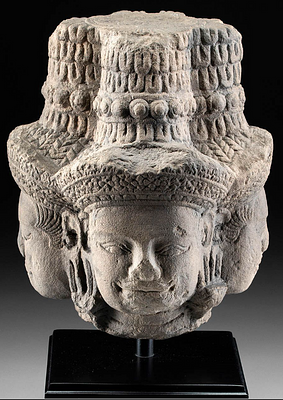Chavin Cupisnique Blackware Shaman Stirrup Vessel
About Seller
686 S Taylor Ave, Ste 106
Louisville, CO 80027
United States
Selling antiquities, ancient and ethnographic art online since 1993, Artemis Gallery specializes in Classical Antiquities (Egyptian, Greek, Roman, Near Eastern), Asian, Pre-Columbian, African / Tribal / Oceanographic art. Our extensive inventory includes pottery, stone, metal, wood, glass and textil...Read more
Two ways to bid:
- Leave a max absentee bid and the platform will bid on your behalf up to your maximum bid during the live auction.
- Bid live during the auction and your bids will be submitted real-time to the auctioneer.
Bid Increments
| Price | Bid Increment |
|---|---|
| $0 | $25 |
| $300 | $50 |
| $1,000 | $100 |
| $2,000 | $250 |
| $5,000 | $500 |
| $10,000 | $1,000 |
| $20,000 | $2,500 |
| $50,000 | $5,000 |
| $100,000 | $10,000 |
| $200,000 | $20,000 |
About Auction
Jun 29, 2023
Artemis Fine Arts info@artemisfinearts.com
- Lot Description
Pre-Columbian, Northern Coast of Peru, Cupisnique / Chavin culture, ca. 1250 to 500 BCE. An enticing pottery stirrup vessel in the form of a seated shaman in the process of a hallucinogenic trance, presenting huge eyes with bulging pupils indicating drug-induced dilation, a crooked mouth, and arms held nervously to his chest in an anxious posture. Note the artist's use of texture in the rough surface of his body sharply contrasting the smoothness of his limbs, suggesting he is enveloped in a furry tunic or perhaps undergoing shamanic transformation into a fur-coated animal. A prominent spiral ornament projects from the top of his head, accentuating the hypnotic nature of this exquisite piece. Size: 5.7" L x 4.8" W x 8.9" H (14.5 cm x 12.2 cm x 22.6 cm)
The relationship between the Chavin culture and the Cupisnique culture is not well understood and the subject of ongoing archaeological investigations, and the names are sometimes used interchangeably. The Chavin people lived in the northern Highland Andes, and their capital, Chavin de Huantar, is an UNESCO World Heritage Site. The artwork of Chavin represents the first widespread style in the Andes. The center of Chavin de Huantar is a massive, flat-topped pyramid, surrounded by lower platforms. Between 1200 and 500 BCE the pyramid space was used for religious ceremonies. The Old Temple, constructed very early in the history of the site, consists of a series of passageways built around a circular courtyard; within were carved stone monuments showing jaguars, serpents, and other figures with transformative and/or anthropomorphic features. At the very center is a towering stone stela depicting an anthropomorphic figure with a jaguar head and a human body, believed to be Lanzon, the chief deity of Chavin. Researchers believe that worshippers ingested hallucinogenic drugs and then were led in the dark through the labyrinthine passageways - the eerie acoustics and complicated floor plan purposefully designed to disorient people before entering the central courtyard and coming abruptly face-to-face with the snarling features of the god. The San Pedro plant has hallucinogenic properties; ritual participants who ingested the substance may have perceived themselves transforming into one of several powerful animals such as jaguars or serpents.
According to the consignor, this piece has been published in "Chavin: Spirits, Shamans, and Hallucinogenics. Ancient Art from South America," Copenhagen: published in cooperation with the National Museum of Denmark, June 1995.Provenance: private Hawaii collection, acquired 2000 to 2010
All items legal to buy/sell under U.S. Statute covering cultural patrimony Code 2600, CHAPTER 14, and are guaranteed to be as described or your money back.
A Certificate of Authenticity will accompany all winning bids.
We ship worldwide and handle all shipping in-house for your convenience.
#179861Condition
Professionally repaired and restored with repainting in areas, but all done very well with indecipherable break lines. Some minor nicks and abrasions, commensurate with age. Otherwise, excellent presentation with impressive detail and light earthen deposits in areas.
- Shipping Info
-
All shipping is handled in-house for your convenience. Your invoice from Artemis Gallery will include shipping calculation instructions. If in doubt, please inquire BEFORE bidding for estimated shipping costs for individual items.
-
- Buyer's Premium



 EUR
EUR CAD
CAD AUD
AUD GBP
GBP MXN
MXN HKD
HKD CNY
CNY MYR
MYR SEK
SEK SGD
SGD CHF
CHF THB
THB















